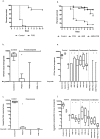Development of azole resistance in Aspergillus fumigatus during azole therapy associated with change in virulence
- PMID: 20404915
- PMCID: PMC2852403
- DOI: 10.1371/journal.pone.0010080
Development of azole resistance in Aspergillus fumigatus during azole therapy associated with change in virulence
Abstract
Four sequential Aspergillus fumigatus isolates from a patient with chronic granulomatous disease (CGD) eventually failing azole-echinocandin combination therapy were investigated. The first two isolates (1 and 2) were susceptible to antifungal azoles, but increased itraconazole, voriconazole and posaconazole MICs were found for the last two isolates (3 and 4). Microsatellite typing showed that the 4 isolates were isogenic, suggesting that resistance had been acquired during azole treatment of the patient. An immunocompromised mouse model confirmed that the in vitro resistance corresponded with treatment failure. Mice challenged with the resistant isolate 4 failed to respond to posaconazole therapy, while those infected by susceptible isolate 2 responded. Posaconazole-anidulafungin combination therapy was effective in mice challenged with isolate 4. No mutations were found in the Cyp51A gene of the four isolates. However, expression experiments of the Cyp51A showed that the expression was increased in the resistant isolates, compared to the azole-susceptible isolates. The microscopic morphology of the four isolates was similar, but a clear alteration in radial growth and a significantly reduced growth rate of the resistant isolates on solid and in broth medium was observed compared to isolates 1 and 2 and to unrelated wild-type controls. In the mouse model the virulence of isolates 3 and 4 was reduced compared to the susceptible ones and to wild-type controls. For the first time, the acquisition of azole resistance despite azole-echinocandin combination therapy is described in a CGD patient and the resistance demonstrated to be directly associated with significant change of virulence.
Conflict of interest statement
Figures




References
-
- Walsh TJ, Anaissie EJ, Denning DW, Herbrecht R, Kontoyiannis DP, et al. Treatment of aspergillosis: clinical practice guidelines of the Infectious Diseases Society of America. Clin Infect Dis. 2008;46:327–360. - PubMed
-
- Howard SJ, Webster I, Moore CB, Gardiner RE, Park S, et al. Multi-azole resistance in Aspergillus fumigatus. Int J Antimicrob Agents. 2006;28:450–453. - PubMed
-
- Verweij PE, Mellado E, Melchers WJ. Multiple-triazole-resistant aspergillosis. N Engl J Med. 2007;356:1481–1483. - PubMed
Publication types
MeSH terms
Substances
LinkOut - more resources
Full Text Sources
Other Literature Sources

